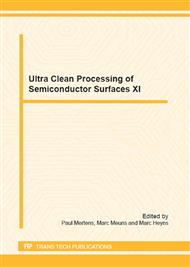p.269
p.274
p.277
p.283
p.289
p.293
p.297
p.301
p.305
How to Overcome the Effects of Silicon Build-Up during Solar Cell Wet Chemical Processing
Abstract:
Although the chemical reaction is well known, the anisotropic etching of Si in alkaline solutions is a complex process. This is particularly true in the solar industry where a large mass of silicon is typically introduced into the etch bath. The etch by-products (silicates) affect the balance of the etching specie. If adequate compensation is not made for these by-products, a significant drop in etch rate and an increase in contamination levels is typically noticed. Because of this contamination, production lines would suffer from unpredictable wafer characteristics and hence lower cell performance.
Info:
Periodical:
Pages:
289-292
Citation:
Online since:
December 2012
Authors:
Price:
Сopyright:
© 2013 Trans Tech Publications Ltd. All Rights Reserved
Share:
Citation:



